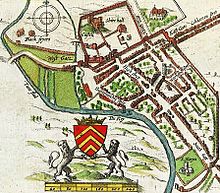St Mary's Church, Cardiff
| St Mary's Church | |
|---|---|

John Speed's 1610 map of Cardiff, showing the southerly location of St Mary's Church, next to the River Taff.
|
|
| Location | Cardiff |
| Country | Wales |
| Denomination | Anglican |
| History | |
| Founded | 1107 |
| Architecture | |
| Status | Demolished |
| Closed | Abandoned after 1701 |
| Demolished | Ruins demolished after 1701 |
St Mary's Church (Eglwys Fair) was an Anglican church in Cardiff, Wales, which stood at the south end of the current St. Mary's Street, from 1107 until 1620. After severe flood damage it was abandoned in 1701 and later replaced at a different location in 1843.
St Mary's was founded as a Benedictine priory in the 1080s, by Robert Fitzhamon (also founder of Tewkesbury Abbey in 1092). However, the site next to the River Taff was a poor one, susceptible to both continual flooding and river erosion. Even after stabilising the foundations, bodies from burials would regularly be washed down the river. The abbey withdrew the monks in 1211.
In 1607, the area of England and Wales bordering the Bristol Channel experienced a devastating flood, now believed to have been a tsunami. The Bristol Channel floods washed away much of St Mary's foundations and it slowly began to collapse.
In 1620, the decision was made to make St John's the main parish church, which was originally just an offshot development. The two churches were worked as one parish, with all burials and some services continuing at St Mary's.
In 1638, the vicar of St Mary's, William Erbery, was forced to resign, his curate Walter Cradock had his licence revoked, and senior members of the congregation were barred from the premises after they refused to read the Book of Sports. Erbery's other curate, William Wroth, eventually conformed. These people, together with others of a similar mind, formed the core of a congregation, that after the English Civil War and subsequent Restoration, in 1696 were granted land in Womanby Street by Alderman John Archer. This allowed them to build the first Trinity Church, later known as a Presbyterian chapel.
...
Wikipedia
